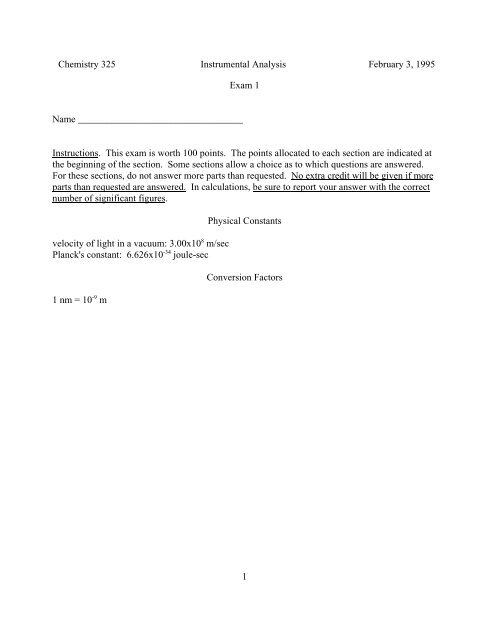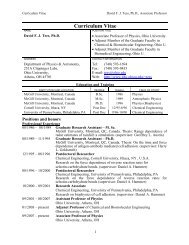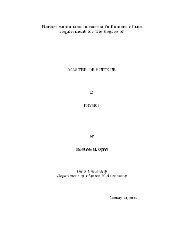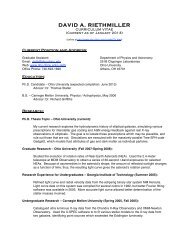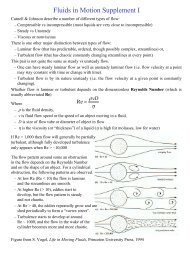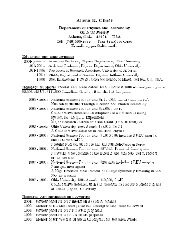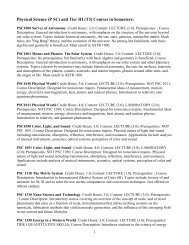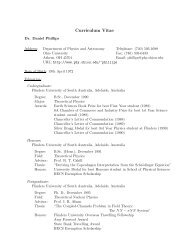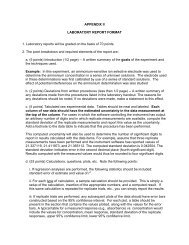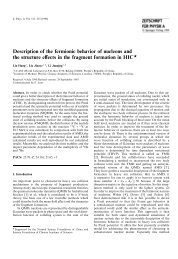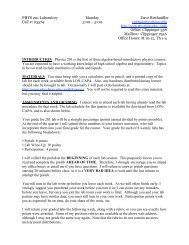Chemistry 325 Instrumental Analysis February 3, 1995 1 Exam 1 ...
Chemistry 325 Instrumental Analysis February 3, 1995 1 Exam 1 ...
Chemistry 325 Instrumental Analysis February 3, 1995 1 Exam 1 ...
You also want an ePaper? Increase the reach of your titles
YUMPU automatically turns print PDFs into web optimized ePapers that Google loves.
<strong>Chemistry</strong> <strong>325</strong> <strong>Instrumental</strong> <strong>Analysis</strong> <strong>February</strong> 3, <strong>1995</strong><br />
<strong>Exam</strong> 1<br />
Name __________________________________<br />
Instructions. This exam is worth 100 points. The points allocated to each section are indicated at<br />
the beginning of the section. Some sections allow a choice as to which questions are answered.<br />
For these sections, do not answer more parts than requested. No extra credit will be given if more<br />
parts than requested are answered. In calculations, be sure to report your answer with the correct<br />
number of significant figures.<br />
velocity of light in a vacuum: 3.00x10 8 m/sec<br />
Planck's constant: 6.626x10 -34 joule-sec<br />
1 nm = 10 -9 m<br />
Physical Constants<br />
Conversion Factors<br />
1
<strong>Chemistry</strong> <strong>325</strong> <strong>Instrumental</strong> <strong>Analysis</strong> <strong>February</strong> 3, <strong>1995</strong><br />
1. (40 points) Circle the correct answer for each of the following:<br />
a. Photomultiplier tubes are not useful as infrared detectors because<br />
(1) Infrared photons do not carry enough energy to eject photoelectrons from the photocathode.<br />
(2) Infrared sources are too intense and cause degradation of the photocathode.<br />
(3) Infrared sources output a light beam that is too large in diameter to be compatible with the<br />
photomultiplier tube.<br />
(4) None of the above.<br />
b. In an experiment based on Beer's Law,<br />
(1) Increasing the sample pathlength will increase the transmittance.<br />
(2) Increasing absorptivity will increase the transmittance.<br />
(3) Decreasing concentration will decrease the transmittance.<br />
(4) Increasing the sample pathlength will increase the absorbance.<br />
c. A photon whose wavelength is 510 nm is<br />
(1) a visible photon<br />
(2) an ultraviolet photon<br />
(3) an infrared photon<br />
(4) a microwave photon<br />
d. Which of the following is false?<br />
(1) Visible photons carry more energy than infrared photons.<br />
(2) Microwave photons carry more energy than infrared photons.<br />
(3) Ultraviolet photons carry more energy than visible photons.<br />
(4) X-ray photons carry more energy than microwave photons.<br />
e. The calculation (0.203 + 0.139) / 2.766 should be reported as<br />
(1) 0.1236<br />
(2) 0.123<br />
(3) 0.124<br />
(4) 0.12<br />
f. Given the grating equation, it can be seen that<br />
(1) the distance between the grooves of a diffraction grating has no effect on its performance.<br />
(2) the angle of incidence of photons striking a diffraction grating must be held constant if the<br />
grating is to function properly.<br />
(3) the angle at which a photon reflects from the grating is unique for each wavelength.<br />
(4) None of the above.
<strong>Chemistry</strong> <strong>325</strong> <strong>Instrumental</strong> <strong>Analysis</strong> <strong>February</strong> 3, <strong>1995</strong><br />
g. A D 2 arc lamp<br />
(1) is the most widely used source of visible photons.<br />
(2) is the most widely used source of ultraviolet photons.<br />
(3) is the most widely used infrared source.<br />
(4) has a continuous output spanning the ultraviolet and visible ranges.<br />
h. Double beam spectrometers<br />
(1) employ an optical chopper or beam director to alternate the source beam between the<br />
reference and sample compartments.<br />
(2) usually employ a motor drive to move the dispersive element in the monochromator.<br />
(3) automatically correct for changes in source output with wavelength.<br />
(4) All of the above.<br />
i. Which of the following is true?<br />
(1) If an analysis is accurate, it must also be precise.<br />
(2) A precise analytical measurement will always have a small relative standard deviation.<br />
(3) If an analysis is reproducible, it will be accurate.<br />
(4) None of the above.<br />
j. The presence of I 2 in a tungsten halogen source<br />
(1) causes the source output to shift to longer wavelengths.<br />
(2) causes the source output to shift to shorter wavelengths.<br />
(3) increases the lifetime of the filament by preventing oxygen from reacting with the tungsten<br />
filament.<br />
(4) increases the lifetime of the bulb by causing vaporized tungsten to redeposit on the filament.<br />
2. (40 points) Answer five of the following in one or two sentences:<br />
a. When a molecule absorbs light, it increases in energy. It then returns to a lower energy state by<br />
releasing energy. Name two forms of energy that the molecule can release.<br />
b. Name one advantage offered by the method of standard additions over a conventional analysis<br />
based on the construction of a calibration curve.
<strong>Chemistry</strong> <strong>325</strong> <strong>Instrumental</strong> <strong>Analysis</strong> <strong>February</strong> 3, <strong>1995</strong><br />
c. What is the function of a monochromator in a spectrometer that employs a tungsten halogen<br />
source?<br />
d. What is the purpose of the chain of dynodes in a photomultiplier tube?<br />
e. In a ultraviolet-visible spectrometer, why is the sample placed after the monochromator?<br />
f. Compute the energy in joules of a photon whose wavelength is 321 nm.<br />
3. (10 points) You are given the following information regarding the precision of four pipets:<br />
volume standard deviation<br />
1 mL 0.006 mL<br />
7 mL 0.02 mL<br />
9 mL 0.02 mL<br />
15 mL 0.03 mL<br />
If you wish to deliver 16 mL, compute the error in each of the two possible delivery methods: (1)<br />
15 mL + 1 mL or (2) 9 mL + 7 mL.
<strong>Chemistry</strong> <strong>325</strong> <strong>Instrumental</strong> <strong>Analysis</strong> <strong>February</strong> 3, <strong>1995</strong><br />
4. (10 points) The drug tolbutamine (FW=270) has a molar absorptivity of 703 cm -1 mole -1 L at 262<br />
nm. One tablet weighing 1.113 g is dissolved in water and diluted to a volume of 2000 mL in a<br />
volumetric flask. If the solution exhibits an absorbance at 262 nm equal to 0.687 (1.0 cm<br />
pathlength cell), what is the weight percent of tolbutamine in the tablet?


